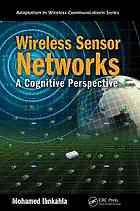Table Of ContentElectrical Engineering Ib
n
k
a
h
Wireless Sensor Networks la
W
A Cognitive Perspective
i
r
e
l
With classical techniques for data transmission soon reaching their e
limitations, cognitive approaches may offer a solution to user requirements
s
for better coverage, connectivity, security, and energy efficiency at
s
lower cost. Wireless Sensor Networks: A Cognitive Perspective
presents a unified view of the state of the art of cognitive approaches
S
in telecommunications. A benchmark in the field, it brings together
research that has previously been scattered throughout conference and e
journal papers.
n
After a review of the cognitive concept and approaches, the book outlines a s
generic architecture for cognition in wireless sensor networks. It then targets o
specific issues that need to be addressed through cognition, from cognitive
r
radio and spectrum access to routing protocols. The book also explores
how to use weighted cognitive maps to improve network lifetime through N
optimizing routing, medium access, and power control while fulfilling end-
to-end goals. The final chapter discusses the implementation of hardware e
for GPS/INS-enabled wireless sensor networks. This addresses an important t
need for real-time node position information in many wireless sensor network w
applications and communication protocols.
o
Written in a tutorial style, the book supplies an in-depth survey of each topic, r
accompanied by detailed descriptions of the algorithms and protocols. It also k
provides a step-by-step analysis of the various communications systems
s
through extensive computer simulations and illustrations. Examples cover
environmental monitoring, vehicular communications, tracking, and more.
A comprehensive overview of cognitive communications in wireless sensor A
C
networks, this work lays the foundations for readers to participate in a new
o
g
era of research in this emerging field. n
i
t
i
v
e
P
e
r
s
p
e
c
K12430 t
i
v
e
ISBN: 978-1-4398-5277-4
90000
9 781439 852774
K12430_COVER_final.indd 1 8/13/12 2:16 PM
Adaptation in Wireless Communications
Series Editor: Mohamed Ibnkahla
Wireless Sensor Networks: A Cognitive Perspective
Mohamed Ibnkahla
Mohamed Ibnkahla
CRC Press
Taylor & Francis Group
6000 Broken Sound Parkway NW, Suite 300
Boca Raton, FL 33487-2742
© 2013 by Taylor & Francis Group, LLC
CRC Press is an imprint of Taylor & Francis Group, an Informa business
No claim to original U.S. Government works
Version Date: 20120809
International Standard Book Number-13: 978-1-4398-5281-1 (eBook - PDF)
This book contains information obtained from authentic and highly regarded sources. Reasonable
efforts have been made to publish reliable data and information, but the author and publisher cannot
assume responsibility for the validity of all materials or the consequences of their use. The authors and
publishers have attempted to trace the copyright holders of all material reproduced in this publication
and apologize to copyright holders if permission to publish in this form has not been obtained. If any
copyright material has not been acknowledged please write and let us know so we may rectify in any
future reprint.
Except as permitted under U.S. Copyright Law, no part of this book may be reprinted, reproduced,
transmitted, or utilized in any form by any electronic, mechanical, or other means, now known or
hereafter invented, including photocopying, microfilming, and recording, or in any information stor-
age or retrieval system, without written permission from the publishers.
For permission to photocopy or use material electronically from this work, please access www.copy-
right.com (http://www.copyright.com/) or contact the Copyright Clearance Center, Inc. (CCC), 222
Rosewood Drive, Danvers, MA 01923, 978-750-8400. CCC is a not-for-profit organization that pro-
vides licenses and registration for a variety of users. For organizations that have been granted a pho-
tocopy license by the CCC, a separate system of payment has been arranged.
Trademark Notice: Product or corporate names may be trademarks or registered trademarks, and are
used only for identification and explanation without intent to infringe.
Visit the Taylor & Francis Web site at
http://www.taylorandfrancis.com
and the CRC Press Web site at
http://www.crcpress.com
Contents
Preface.......................................................................................................................ix
Acronyms..............................................................................................................xiii
1 Introduction to Cognitive Approaches in Wireless Sensor Networks......1
1.1. Introduction............................................................................................1
1.1.1. Application.Layer.Requirements............................................3
1.1.2. Physical.Layer.Constraints.and.Requirements....................4
1.1.3. Network.Status.Sensors...........................................................4
1.2. Related.Work...........................................................................................5
1.2.1. Knowledge.Plane.and.Cognitive.Networks..........................6
1.2.2. Cognitive.Techniques.Used.in.Sensor.Networks.................8
1.3. A.Generic.Architecture.for.Cognitive.Wireless.Sensor.
Networks...............................................................................................12
1.3.1. ZigBee.Stack.............................................................................15
1.3.2. Network.Status.Sensors.........................................................15
1.3.3. Inputs.from.the.Physical.Layer.............................................15
1.3.4. Change.Monitoring.Engine...................................................16
1.3.5. Knowledge.Base......................................................................16
1.3.6. Cognitive.Decision-Making.Engine.....................................17
1.3.7. Optimization.Engine..............................................................18
1.3.8. Interaction.among.the.Cognitive.Components..................18
1.4. Conclusion.............................................................................................20
References........................................................................................................21
2 Cognitive Radio Networks and Dynamic Spectrum Access................23
2.1. Introduction..........................................................................................23
2.1.1. History.of.Cognitive.Radio...................................................23
2.1.2. MIMO.and.Cooperative.Diversity.Techniques..................24
2.2. Spectrum.Awareness...........................................................................26
2.2.1. Spectrum.Sensing.Challenges..............................................28
2.2.2. Spectrum.Sensing.Methods..................................................30
2.3. Cooperative.Sensing............................................................................35
2.3.1. Narrowband.Cooperative.Sensing.......................................35
2.3.2. Wideband.Cooperative.Sensing...........................................38
2.4. Dynamic.Spectrum.Access.................................................................39
2.4.1. MIMO.Systems.for.Spectrum.Access...................................41
2.4.2. Cooperative.Spectrum.Access..............................................44
2.5. Conclusion.............................................................................................46
References........................................................................................................46
v
vi Contents
3 Adaptive Modulation, Adaptive Power Allocation, and
Adaptive Medium Access............................................................................51
3.1. Introduction..........................................................................................51
3.2. System.Model........................................................................................53
3.2.1. Information.Source.and.Sink................................................53
3.2.2. Transmitter..............................................................................53
3.2.3. Receiver....................................................................................54
3.2.4. Wireless.Channel....................................................................54
3.2.5. Lognormal.Shadowing.Channel.Model..............................54
3.2.6. Rician.Fading.Channel.Model..............................................55
3.3. Adaptive.Transmission.and.Feedback.Communication.System......55
3.3.1. Introduction.............................................................................55
3.3.2. Adaptive.System.Design........................................................55
3.3.3. Link.Adaptations....................................................................56
3.3.4. Link.Adaptation.for.Energy-Constrained.Networks........57
3.3.5. Adaptive.Techniques..............................................................58
3.4. Multihop.Relay.Network.and.Energy-Constrained.Network.
Analysis.................................................................................................63
3.4.1. Energy.Consumption.with.Adaptation.Techniques..........63
3.4.2. Single-Hop.Discrete.Rate.Continuous.Power.
Adaptation...............................................................................64
3.4.3. Multihop.Relay.Networks.....................................................65
3.4.4. MAC.Layer.Adaptive.Modulation.and.Adaptive.Sleep....69
3.5. Simulation.Examples.and.Illustrations.............................................73
3.5.1. Simulation.Objective..............................................................73
3.5.2. Energy.Optimization.............................................................74
3.5.3. Power.Control.Adaptation.Policies......................................88
3.5.4. Two-Link.Relay.Network.Adaptation..................................88
3.5.5. Performance.of.Commercial.WSN.Nodes...........................92
3.6. Conclusions...........................................................................................96
References........................................................................................................97
4 Cross-Layer Approaches to QoS Routing in Wireless Multihop
Networks.......................................................................................................101
4.1. Introduction........................................................................................101
4.2. Design.Challenges.and.Considerations..........................................103
4.2.1. QoS.Metrics............................................................................103
4.2.2. Design.Challenges................................................................104
4.2.3. Network.Resources.and.Performance.Metrics.................106
4.3. Taxonomy.of.QoS.Routing.Protocols.in.Multihop.Networks.........108
4.3.1. QoS.Routing.in.MANETs....................................................108
4.3.2. QoS.Routing.in.WMNs........................................................114
4.3.3. QoS.Routing.in.VANETs......................................................117
Contents vii
4.3.4. QoS.Routing.in.WSNs..........................................................123
4.3.5. Limitations.to.Routing.Design.across.Different.
Networks................................................................................127
4.4. Comparison.between.QoS.Routing.Protocols...............................128
4.5. Challenges.and.Future.Directions..................................................133
4.6. Conclusions.........................................................................................136
References......................................................................................................136
5 Cognitive Diversity Routing.....................................................................141
5.1. Overview.of.Routing.Protocols.in Wireless.Sensor.Networks.......141
5.1.1. Wireless.Sensor.Network.Routing.Protocols....................141
5.1.2. Energy-Aware.Protocols......................................................144
5.1.3. Diversity.Routing..................................................................147
5.1.4. Cognitive.Protocols..............................................................148
5.2. System.Models....................................................................................149
5.2.1. The.Propagation.Model........................................................150
5.2.2. Network.Lifetime..................................................................151
5.3. Cognitive.Diversity.Routing.............................................................153
5.3.1. Cognitive.Diversity.Routing.Methodology......................153
5.3.2. Implementation.in.OPNET.Modeler.15.0..........................156
5.3.3. Pseudo-Code.for.Cognitive.Diversity.Routing.................157
5.4. Priority.Node.Selection.....................................................................161
5.5. Performance.Evaluation....................................................................163
5.5.1. Grid.Deployment..................................................................165
5.5.2. Deployment.with.Forced.Path............................................172
5.5.3. Random.Deployment...........................................................174
5.5.4. Node.Density.and.Scalability.............................................175
5.5.5. Optimization.........................................................................181
5.5.6. Giving.Emphasis.to.the.Channel.Profile...........................182
5.6. Conclusion...........................................................................................189
References......................................................................................................190
6 Enabling Cognition through Weighted Cognitive Maps....................193
6.1. Introduction........................................................................................193
6.2. Related.Work.......................................................................................194
6.3. Fundamentals.of.WCM.....................................................................195
6.4. Designing.WCMs.to.Achieve.Cognition.in.WSNs........................198
6.4.1. Designing.a.WCM.for.Transmit.Power,.Data.Rate,.
and.Duty.Cycle.Adaptation.................................................199
6.4.2. Designing.a.WCM.to.Guarantee.Connectivity.and.
Coverage.................................................................................203
6.4.3. Designing.a.WCM.for.Congestion.Control.......................205
6.4.4. End-to-End.Goal.and.the.Overall.WCM...........................207
6.5. Simulation.Results.............................................................................209
6.5.1. Evaluation.Using.Uniform.Random.Topology.................210
viii Contents
6.5.2. Evaluation.Using.Bottleneck.Paths....................................214
6.5.3. Complexity.of.the.System....................................................216
6.6. Conclusions.........................................................................................218
References......................................................................................................218
7 Hardware Architecture for GPS/INS-Enabled Wireless Sensor
Networks.......................................................................................................221
7.1. Introduction........................................................................................221
7.2. Hardware.Implementation...............................................................224
7.2.1. GPS.and.INS.Data.Acquisition...........................................224
7.2.2. Navigation.Data.Processing................................................225
7.2.3. Power.Management.MCU...................................................226
7.2.4. Wireless.Radio.Frequency.Transceiver..............................226
7.2.5. Power.Supply.........................................................................227
7.3. System.Software.Design...................................................................228
7.3.1. System.Initialization.............................................................228
7.3.2. System.Power.Management................................................230
7.3.3. DSP.Memory.Allocation......................................................231
7.3.4. ZigBee.Node.Software.Design............................................232
7.4. Test.Results..........................................................................................234
7.4.1. Equipment.and.Setup...........................................................234
7.4.2. Real-Time.Performance.Analysis.......................................236
7.4.3. Random.Error.Modeling......................................................237
7.4.4. Open.Field.Tests....................................................................239
7.5. Conclusion...........................................................................................244
References......................................................................................................245

